International Strategic Alliance: Star Alliance Report Analysis
VerifiedAdded on 2022/11/29
|14
|4163
|472
Report
AI Summary
This report provides a comprehensive analysis of the Star Alliance, a multilateral strategic alliance in the airline industry, involving 27 member airlines. It begins with an executive summary and an introduction to strategic alliances, followed by a literature review that demonstrates the use of international strategic alliances in foreign market expansion and discusses the motivations behind forming such alliances. The report critically assesses the benefits and challenges faced by partners within the Star Alliance, focusing on aspects such as market share increase, customer base expansion, and competitive advantages. It examines how the alliance facilitates access to new markets, reduces risks, and fosters brand awareness. The report also explores the challenges of the alliance, including potential conflicts and the need for common goals. Finally, the report concludes with recommendations for alternative market entry strategies, specifically joint ventures, and a detailed discussion of the Star Alliance's impact on the airline industry's growth and structure.

Individual Academic Report
Paraphrase This Document
Need a fresh take? Get an instant paraphrase of this document with our AI Paraphraser
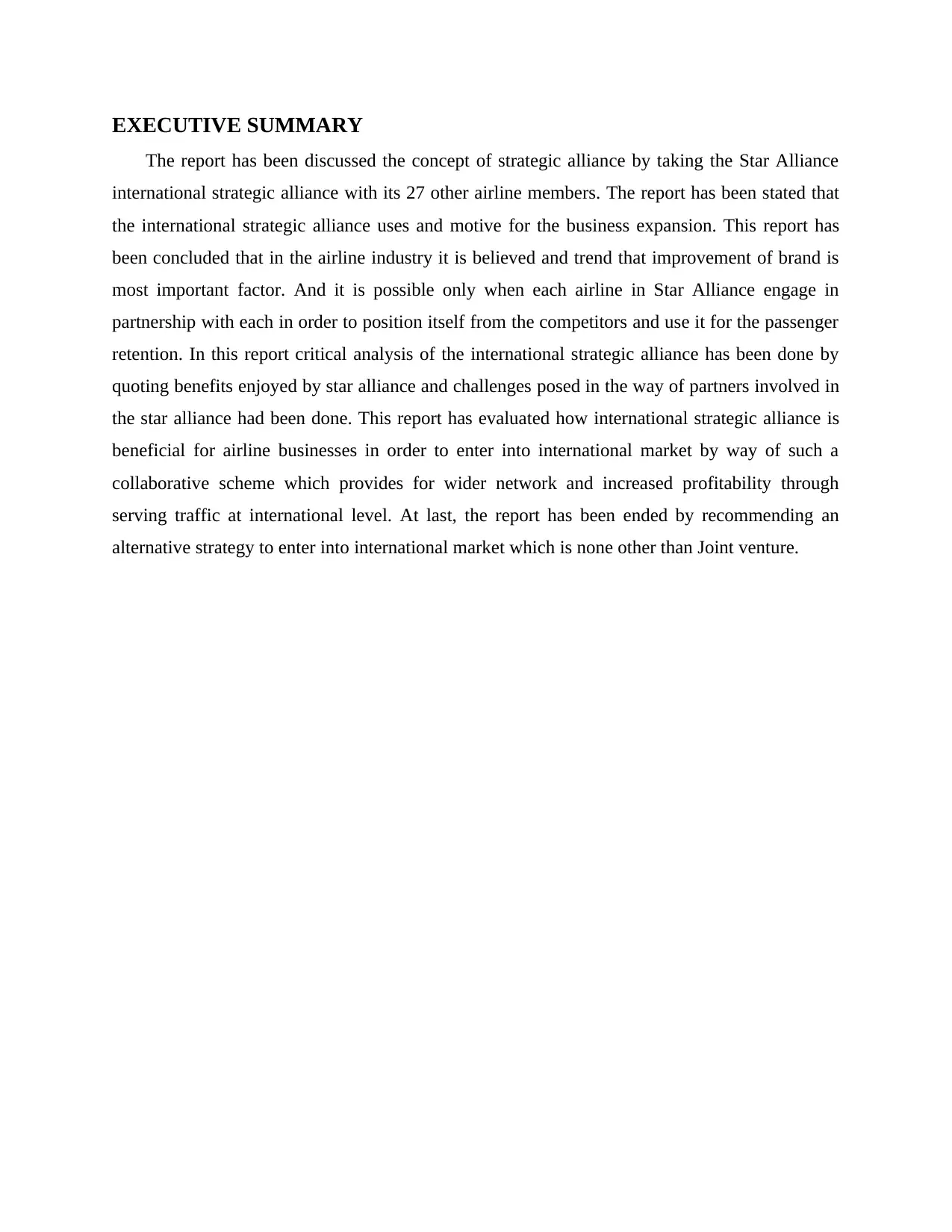
EXECUTIVE SUMMARY
The report has been discussed the concept of strategic alliance by taking the Star Alliance
international strategic alliance with its 27 other airline members. The report has been stated that
the international strategic alliance uses and motive for the business expansion. This report has
been concluded that in the airline industry it is believed and trend that improvement of brand is
most important factor. And it is possible only when each airline in Star Alliance engage in
partnership with each in order to position itself from the competitors and use it for the passenger
retention. In this report critical analysis of the international strategic alliance has been done by
quoting benefits enjoyed by star alliance and challenges posed in the way of partners involved in
the star alliance had been done. This report has evaluated how international strategic alliance is
beneficial for airline businesses in order to enter into international market by way of such a
collaborative scheme which provides for wider network and increased profitability through
serving traffic at international level. At last, the report has been ended by recommending an
alternative strategy to enter into international market which is none other than Joint venture.
The report has been discussed the concept of strategic alliance by taking the Star Alliance
international strategic alliance with its 27 other airline members. The report has been stated that
the international strategic alliance uses and motive for the business expansion. This report has
been concluded that in the airline industry it is believed and trend that improvement of brand is
most important factor. And it is possible only when each airline in Star Alliance engage in
partnership with each in order to position itself from the competitors and use it for the passenger
retention. In this report critical analysis of the international strategic alliance has been done by
quoting benefits enjoyed by star alliance and challenges posed in the way of partners involved in
the star alliance had been done. This report has evaluated how international strategic alliance is
beneficial for airline businesses in order to enter into international market by way of such a
collaborative scheme which provides for wider network and increased profitability through
serving traffic at international level. At last, the report has been ended by recommending an
alternative strategy to enter into international market which is none other than Joint venture.
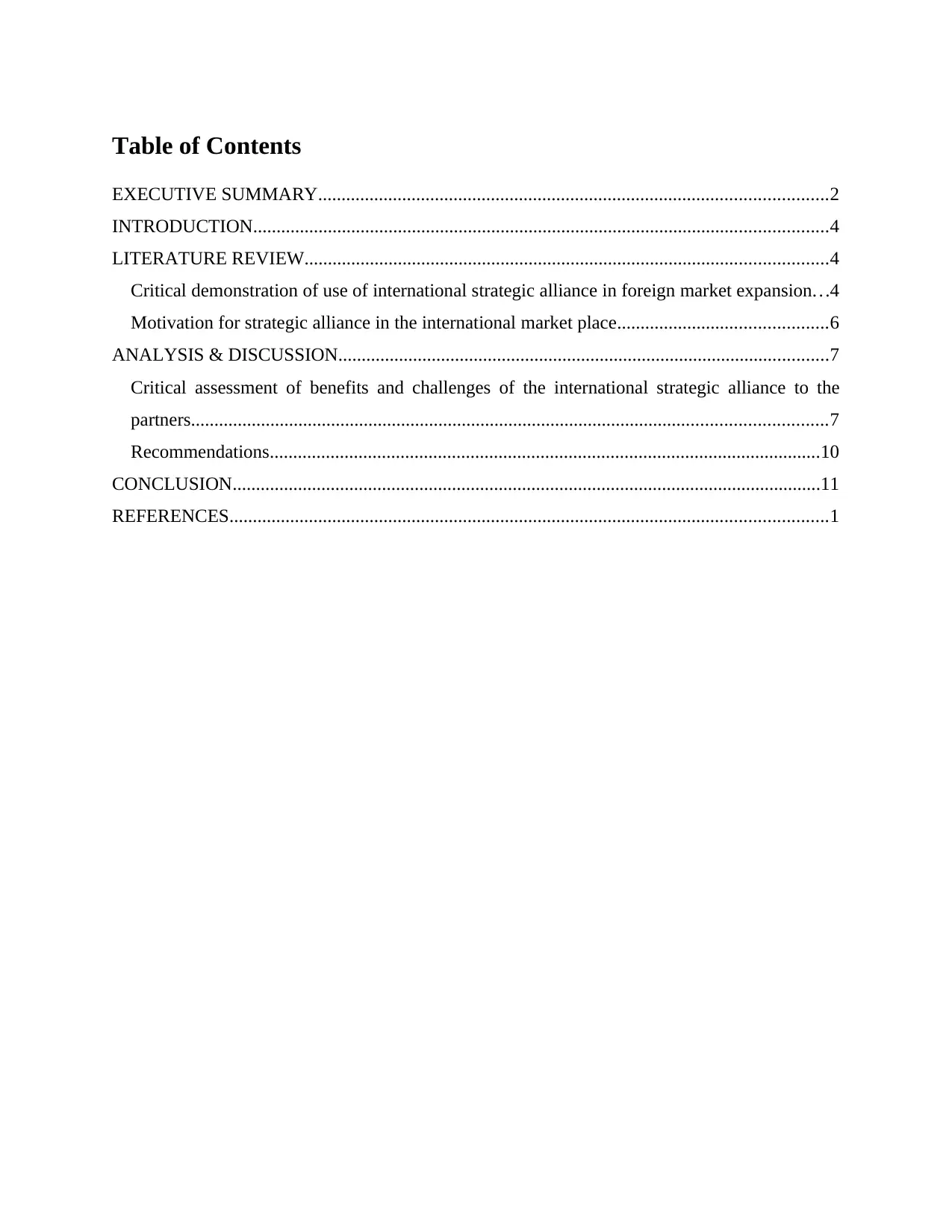
Table of Contents
EXECUTIVE SUMMARY.............................................................................................................2
INTRODUCTION...........................................................................................................................4
LITERATURE REVIEW................................................................................................................4
Critical demonstration of use of international strategic alliance in foreign market expansion...4
Motivation for strategic alliance in the international market place.............................................6
ANALYSIS & DISCUSSION.........................................................................................................7
Critical assessment of benefits and challenges of the international strategic alliance to the
partners........................................................................................................................................7
Recommendations......................................................................................................................10
CONCLUSION..............................................................................................................................11
REFERENCES................................................................................................................................1
EXECUTIVE SUMMARY.............................................................................................................2
INTRODUCTION...........................................................................................................................4
LITERATURE REVIEW................................................................................................................4
Critical demonstration of use of international strategic alliance in foreign market expansion...4
Motivation for strategic alliance in the international market place.............................................6
ANALYSIS & DISCUSSION.........................................................................................................7
Critical assessment of benefits and challenges of the international strategic alliance to the
partners........................................................................................................................................7
Recommendations......................................................................................................................10
CONCLUSION..............................................................................................................................11
REFERENCES................................................................................................................................1
⊘ This is a preview!⊘
Do you want full access?
Subscribe today to unlock all pages.

Trusted by 1+ million students worldwide
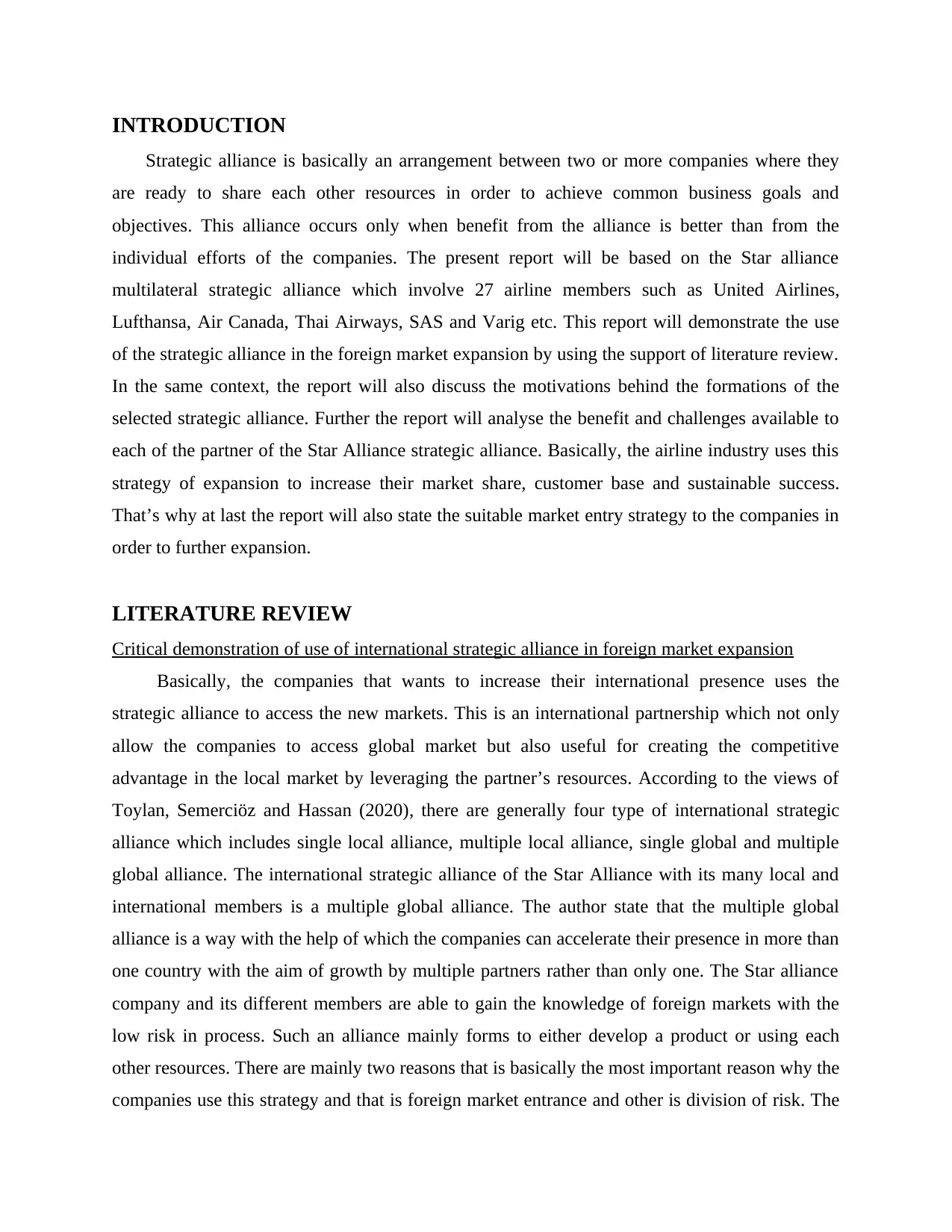
INTRODUCTION
Strategic alliance is basically an arrangement between two or more companies where they
are ready to share each other resources in order to achieve common business goals and
objectives. This alliance occurs only when benefit from the alliance is better than from the
individual efforts of the companies. The present report will be based on the Star alliance
multilateral strategic alliance which involve 27 airline members such as United Airlines,
Lufthansa, Air Canada, Thai Airways, SAS and Varig etc. This report will demonstrate the use
of the strategic alliance in the foreign market expansion by using the support of literature review.
In the same context, the report will also discuss the motivations behind the formations of the
selected strategic alliance. Further the report will analyse the benefit and challenges available to
each of the partner of the Star Alliance strategic alliance. Basically, the airline industry uses this
strategy of expansion to increase their market share, customer base and sustainable success.
That’s why at last the report will also state the suitable market entry strategy to the companies in
order to further expansion.
LITERATURE REVIEW
Critical demonstration of use of international strategic alliance in foreign market expansion
Basically, the companies that wants to increase their international presence uses the
strategic alliance to access the new markets. This is an international partnership which not only
allow the companies to access global market but also useful for creating the competitive
advantage in the local market by leveraging the partner’s resources. According to the views of
Toylan, Semerciöz and Hassan (2020), there are generally four type of international strategic
alliance which includes single local alliance, multiple local alliance, single global and multiple
global alliance. The international strategic alliance of the Star Alliance with its many local and
international members is a multiple global alliance. The author state that the multiple global
alliance is a way with the help of which the companies can accelerate their presence in more than
one country with the aim of growth by multiple partners rather than only one. The Star alliance
company and its different members are able to gain the knowledge of foreign markets with the
low risk in process. Such an alliance mainly forms to either develop a product or using each
other resources. There are mainly two reasons that is basically the most important reason why the
companies use this strategy and that is foreign market entrance and other is division of risk. The
Strategic alliance is basically an arrangement between two or more companies where they
are ready to share each other resources in order to achieve common business goals and
objectives. This alliance occurs only when benefit from the alliance is better than from the
individual efforts of the companies. The present report will be based on the Star alliance
multilateral strategic alliance which involve 27 airline members such as United Airlines,
Lufthansa, Air Canada, Thai Airways, SAS and Varig etc. This report will demonstrate the use
of the strategic alliance in the foreign market expansion by using the support of literature review.
In the same context, the report will also discuss the motivations behind the formations of the
selected strategic alliance. Further the report will analyse the benefit and challenges available to
each of the partner of the Star Alliance strategic alliance. Basically, the airline industry uses this
strategy of expansion to increase their market share, customer base and sustainable success.
That’s why at last the report will also state the suitable market entry strategy to the companies in
order to further expansion.
LITERATURE REVIEW
Critical demonstration of use of international strategic alliance in foreign market expansion
Basically, the companies that wants to increase their international presence uses the
strategic alliance to access the new markets. This is an international partnership which not only
allow the companies to access global market but also useful for creating the competitive
advantage in the local market by leveraging the partner’s resources. According to the views of
Toylan, Semerciöz and Hassan (2020), there are generally four type of international strategic
alliance which includes single local alliance, multiple local alliance, single global and multiple
global alliance. The international strategic alliance of the Star Alliance with its many local and
international members is a multiple global alliance. The author state that the multiple global
alliance is a way with the help of which the companies can accelerate their presence in more than
one country with the aim of growth by multiple partners rather than only one. The Star alliance
company and its different members are able to gain the knowledge of foreign markets with the
low risk in process. Such an alliance mainly forms to either develop a product or using each
other resources. There are mainly two reasons that is basically the most important reason why the
companies use this strategy and that is foreign market entrance and other is division of risk. The
Paraphrase This Document
Need a fresh take? Get an instant paraphrase of this document with our AI Paraphraser
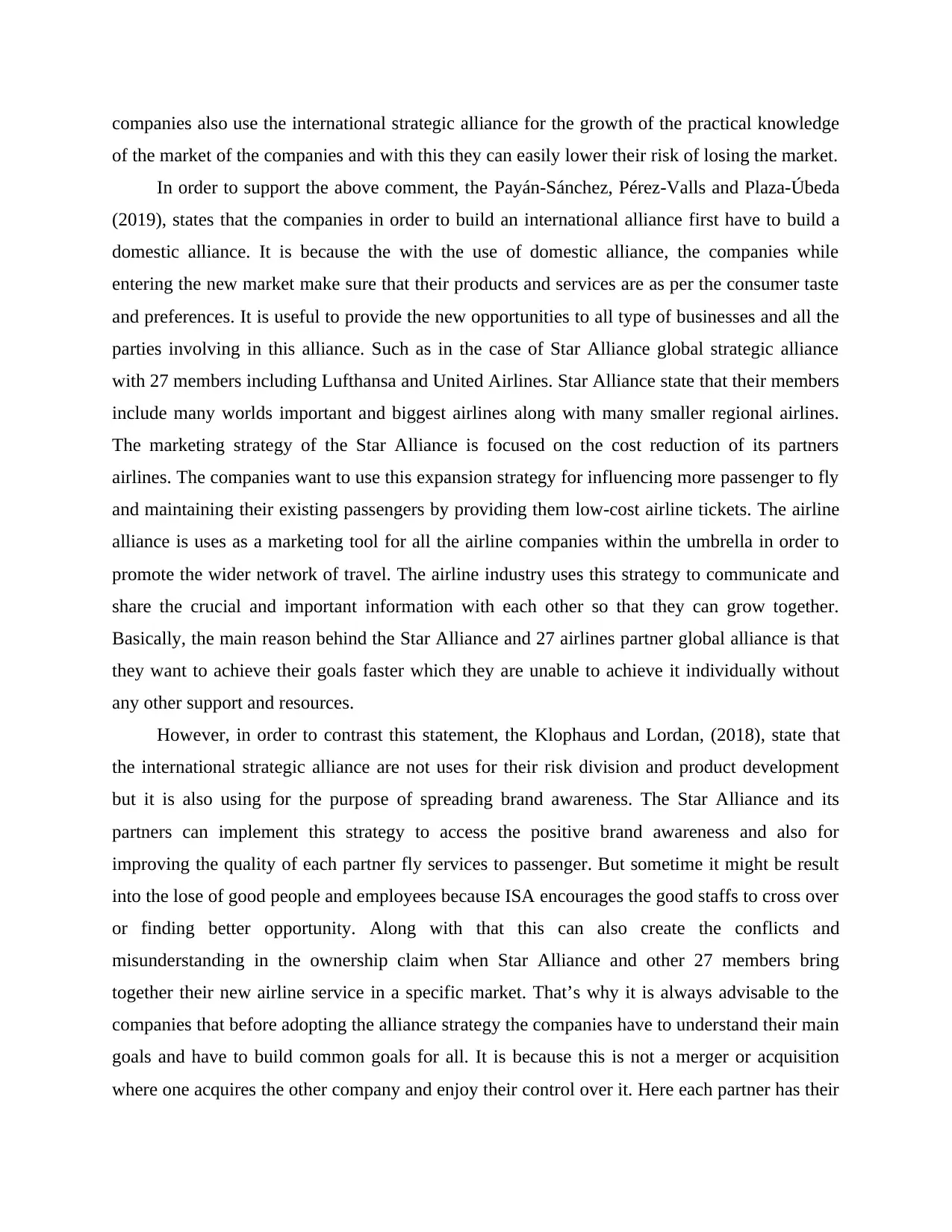
companies also use the international strategic alliance for the growth of the practical knowledge
of the market of the companies and with this they can easily lower their risk of losing the market.
In order to support the above comment, the Payán-Sánchez, Pérez-Valls and Plaza-Úbeda
(2019), states that the companies in order to build an international alliance first have to build a
domestic alliance. It is because the with the use of domestic alliance, the companies while
entering the new market make sure that their products and services are as per the consumer taste
and preferences. It is useful to provide the new opportunities to all type of businesses and all the
parties involving in this alliance. Such as in the case of Star Alliance global strategic alliance
with 27 members including Lufthansa and United Airlines. Star Alliance state that their members
include many worlds important and biggest airlines along with many smaller regional airlines.
The marketing strategy of the Star Alliance is focused on the cost reduction of its partners
airlines. The companies want to use this expansion strategy for influencing more passenger to fly
and maintaining their existing passengers by providing them low-cost airline tickets. The airline
alliance is uses as a marketing tool for all the airline companies within the umbrella in order to
promote the wider network of travel. The airline industry uses this strategy to communicate and
share the crucial and important information with each other so that they can grow together.
Basically, the main reason behind the Star Alliance and 27 airlines partner global alliance is that
they want to achieve their goals faster which they are unable to achieve it individually without
any other support and resources.
However, in order to contrast this statement, the Klophaus and Lordan, (2018), state that
the international strategic alliance are not uses for their risk division and product development
but it is also using for the purpose of spreading brand awareness. The Star Alliance and its
partners can implement this strategy to access the positive brand awareness and also for
improving the quality of each partner fly services to passenger. But sometime it might be result
into the lose of good people and employees because ISA encourages the good staffs to cross over
or finding better opportunity. Along with that this can also create the conflicts and
misunderstanding in the ownership claim when Star Alliance and other 27 members bring
together their new airline service in a specific market. That’s why it is always advisable to the
companies that before adopting the alliance strategy the companies have to understand their main
goals and have to build common goals for all. It is because this is not a merger or acquisition
where one acquires the other company and enjoy their control over it. Here each partner has their
of the market of the companies and with this they can easily lower their risk of losing the market.
In order to support the above comment, the Payán-Sánchez, Pérez-Valls and Plaza-Úbeda
(2019), states that the companies in order to build an international alliance first have to build a
domestic alliance. It is because the with the use of domestic alliance, the companies while
entering the new market make sure that their products and services are as per the consumer taste
and preferences. It is useful to provide the new opportunities to all type of businesses and all the
parties involving in this alliance. Such as in the case of Star Alliance global strategic alliance
with 27 members including Lufthansa and United Airlines. Star Alliance state that their members
include many worlds important and biggest airlines along with many smaller regional airlines.
The marketing strategy of the Star Alliance is focused on the cost reduction of its partners
airlines. The companies want to use this expansion strategy for influencing more passenger to fly
and maintaining their existing passengers by providing them low-cost airline tickets. The airline
alliance is uses as a marketing tool for all the airline companies within the umbrella in order to
promote the wider network of travel. The airline industry uses this strategy to communicate and
share the crucial and important information with each other so that they can grow together.
Basically, the main reason behind the Star Alliance and 27 airlines partner global alliance is that
they want to achieve their goals faster which they are unable to achieve it individually without
any other support and resources.
However, in order to contrast this statement, the Klophaus and Lordan, (2018), state that
the international strategic alliance are not uses for their risk division and product development
but it is also using for the purpose of spreading brand awareness. The Star Alliance and its
partners can implement this strategy to access the positive brand awareness and also for
improving the quality of each partner fly services to passenger. But sometime it might be result
into the lose of good people and employees because ISA encourages the good staffs to cross over
or finding better opportunity. Along with that this can also create the conflicts and
misunderstanding in the ownership claim when Star Alliance and other 27 members bring
together their new airline service in a specific market. That’s why it is always advisable to the
companies that before adopting the alliance strategy the companies have to understand their main
goals and have to build common goals for all. It is because this is not a merger or acquisition
where one acquires the other company and enjoy their control over it. Here each partner has their
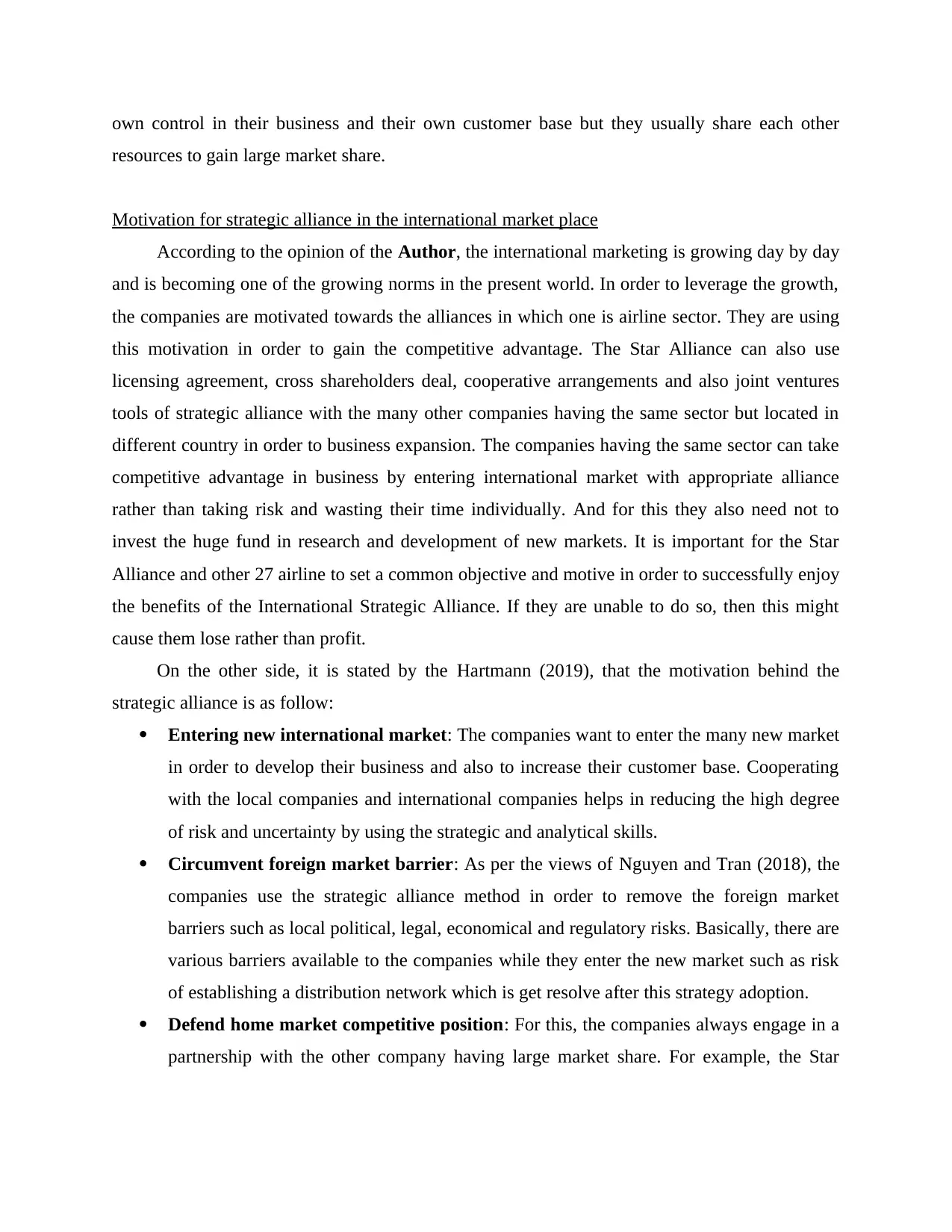
own control in their business and their own customer base but they usually share each other
resources to gain large market share.
Motivation for strategic alliance in the international market place
According to the opinion of the Author, the international marketing is growing day by day
and is becoming one of the growing norms in the present world. In order to leverage the growth,
the companies are motivated towards the alliances in which one is airline sector. They are using
this motivation in order to gain the competitive advantage. The Star Alliance can also use
licensing agreement, cross shareholders deal, cooperative arrangements and also joint ventures
tools of strategic alliance with the many other companies having the same sector but located in
different country in order to business expansion. The companies having the same sector can take
competitive advantage in business by entering international market with appropriate alliance
rather than taking risk and wasting their time individually. And for this they also need not to
invest the huge fund in research and development of new markets. It is important for the Star
Alliance and other 27 airline to set a common objective and motive in order to successfully enjoy
the benefits of the International Strategic Alliance. If they are unable to do so, then this might
cause them lose rather than profit.
On the other side, it is stated by the Hartmann (2019), that the motivation behind the
strategic alliance is as follow:
Entering new international market: The companies want to enter the many new market
in order to develop their business and also to increase their customer base. Cooperating
with the local companies and international companies helps in reducing the high degree
of risk and uncertainty by using the strategic and analytical skills.
Circumvent foreign market barrier: As per the views of Nguyen and Tran (2018), the
companies use the strategic alliance method in order to remove the foreign market
barriers such as local political, legal, economical and regulatory risks. Basically, there are
various barriers available to the companies while they enter the new market such as risk
of establishing a distribution network which is get resolve after this strategy adoption.
Defend home market competitive position: For this, the companies always engage in a
partnership with the other company having large market share. For example, the Star
resources to gain large market share.
Motivation for strategic alliance in the international market place
According to the opinion of the Author, the international marketing is growing day by day
and is becoming one of the growing norms in the present world. In order to leverage the growth,
the companies are motivated towards the alliances in which one is airline sector. They are using
this motivation in order to gain the competitive advantage. The Star Alliance can also use
licensing agreement, cross shareholders deal, cooperative arrangements and also joint ventures
tools of strategic alliance with the many other companies having the same sector but located in
different country in order to business expansion. The companies having the same sector can take
competitive advantage in business by entering international market with appropriate alliance
rather than taking risk and wasting their time individually. And for this they also need not to
invest the huge fund in research and development of new markets. It is important for the Star
Alliance and other 27 airline to set a common objective and motive in order to successfully enjoy
the benefits of the International Strategic Alliance. If they are unable to do so, then this might
cause them lose rather than profit.
On the other side, it is stated by the Hartmann (2019), that the motivation behind the
strategic alliance is as follow:
Entering new international market: The companies want to enter the many new market
in order to develop their business and also to increase their customer base. Cooperating
with the local companies and international companies helps in reducing the high degree
of risk and uncertainty by using the strategic and analytical skills.
Circumvent foreign market barrier: As per the views of Nguyen and Tran (2018), the
companies use the strategic alliance method in order to remove the foreign market
barriers such as local political, legal, economical and regulatory risks. Basically, there are
various barriers available to the companies while they enter the new market such as risk
of establishing a distribution network which is get resolve after this strategy adoption.
Defend home market competitive position: For this, the companies always engage in a
partnership with the other company having large market share. For example, the Star
⊘ This is a preview!⊘
Do you want full access?
Subscribe today to unlock all pages.

Trusted by 1+ million students worldwide

Alliance and its 27 other airline members take competitive advantage in their local
market by using each other resources and information.
Extend the product line: In order to extend the product line, the companies need to
understand the specific market consumer taste and needs. Engaging in the strategic
alliance provide the quick access to the companies to offer new products to the new and
existing customers.
Changing industry structure: As stated by the Kiraci (2019), the motive behind the
multiple global strategic alliance is to increase the expected growth rate of the airline
industry. For example, because of the SA the expected growth rate of the aviation sector
in the globe is 7.6% from the year 2021 to 2026 which help them in changing the overall
structure of the airline.
Acquisition of new skills: One of the most important motive of the Star Alliance
company and its 27 members is to learn a new skill from the action and decision-making
process of each other partners. This also helps them in analysing the updated and
outdated technological skills.
Increase available resources: According to the opinion of Fu, Huang and Liao (2020),
the Star Alliance and other 27 airline companies use each other resources at low cost and
the impact of which their main purpose of cost reduction is also get achieved. Not only
that, the all parties in this alliance are able to generate high revenue in order to compete
their local competitors.
ANALYSIS & DISCUSSION
Critical assessment of benefits and challenges of the international strategic alliance to the
partners
International strategic alliance refers to the collaboration among firms who are geographically
distinct from each other. It is also known as home – host relationship which indicates partnership
between a local firm and foreign firms. As every coin has two aspects which indicates one
brighter side and the other side as gloomier. So, in the same way international strategic alliance
has both benefits and challenges for the partners forming such alliances. These alliances are
formed for attaining mutual business objectives of firms involved. The reason may be any like
resource sharing, utilizing others core competencies and capabilities while manufacturing and
distributing products and services in the international market. So, in this report by keeping in
market by using each other resources and information.
Extend the product line: In order to extend the product line, the companies need to
understand the specific market consumer taste and needs. Engaging in the strategic
alliance provide the quick access to the companies to offer new products to the new and
existing customers.
Changing industry structure: As stated by the Kiraci (2019), the motive behind the
multiple global strategic alliance is to increase the expected growth rate of the airline
industry. For example, because of the SA the expected growth rate of the aviation sector
in the globe is 7.6% from the year 2021 to 2026 which help them in changing the overall
structure of the airline.
Acquisition of new skills: One of the most important motive of the Star Alliance
company and its 27 members is to learn a new skill from the action and decision-making
process of each other partners. This also helps them in analysing the updated and
outdated technological skills.
Increase available resources: According to the opinion of Fu, Huang and Liao (2020),
the Star Alliance and other 27 airline companies use each other resources at low cost and
the impact of which their main purpose of cost reduction is also get achieved. Not only
that, the all parties in this alliance are able to generate high revenue in order to compete
their local competitors.
ANALYSIS & DISCUSSION
Critical assessment of benefits and challenges of the international strategic alliance to the
partners
International strategic alliance refers to the collaboration among firms who are geographically
distinct from each other. It is also known as home – host relationship which indicates partnership
between a local firm and foreign firms. As every coin has two aspects which indicates one
brighter side and the other side as gloomier. So, in the same way international strategic alliance
has both benefits and challenges for the partners forming such alliances. These alliances are
formed for attaining mutual business objectives of firms involved. The reason may be any like
resource sharing, utilizing others core competencies and capabilities while manufacturing and
distributing products and services in the international market. So, in this report by keeping in
Paraphrase This Document
Need a fresh take? Get an instant paraphrase of this document with our AI Paraphraser
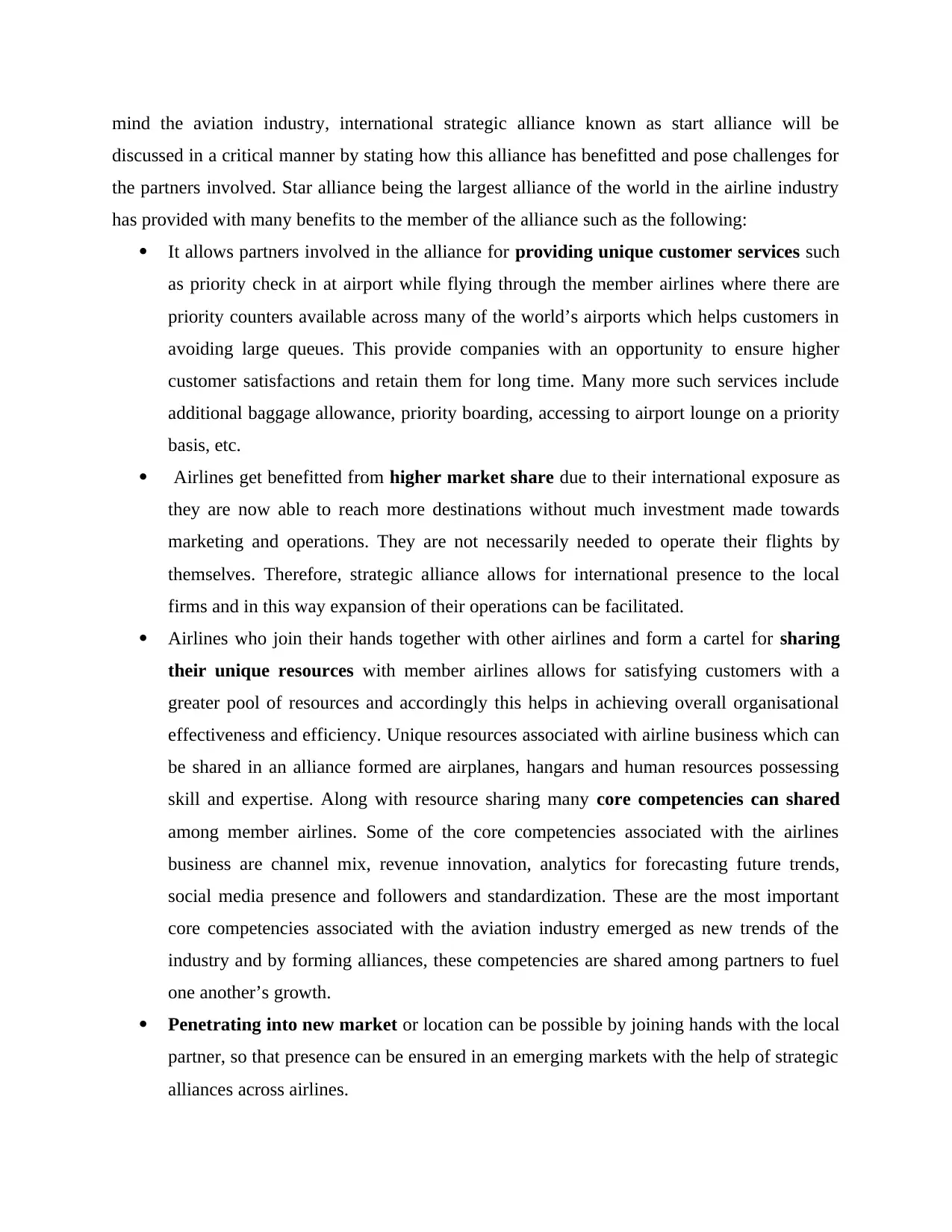
mind the aviation industry, international strategic alliance known as start alliance will be
discussed in a critical manner by stating how this alliance has benefitted and pose challenges for
the partners involved. Star alliance being the largest alliance of the world in the airline industry
has provided with many benefits to the member of the alliance such as the following:
It allows partners involved in the alliance for providing unique customer services such
as priority check in at airport while flying through the member airlines where there are
priority counters available across many of the world’s airports which helps customers in
avoiding large queues. This provide companies with an opportunity to ensure higher
customer satisfactions and retain them for long time. Many more such services include
additional baggage allowance, priority boarding, accessing to airport lounge on a priority
basis, etc.
Airlines get benefitted from higher market share due to their international exposure as
they are now able to reach more destinations without much investment made towards
marketing and operations. They are not necessarily needed to operate their flights by
themselves. Therefore, strategic alliance allows for international presence to the local
firms and in this way expansion of their operations can be facilitated.
Airlines who join their hands together with other airlines and form a cartel for sharing
their unique resources with member airlines allows for satisfying customers with a
greater pool of resources and accordingly this helps in achieving overall organisational
effectiveness and efficiency. Unique resources associated with airline business which can
be shared in an alliance formed are airplanes, hangars and human resources possessing
skill and expertise. Along with resource sharing many core competencies can shared
among member airlines. Some of the core competencies associated with the airlines
business are channel mix, revenue innovation, analytics for forecasting future trends,
social media presence and followers and standardization. These are the most important
core competencies associated with the aviation industry emerged as new trends of the
industry and by forming alliances, these competencies are shared among partners to fuel
one another’s growth.
Penetrating into new market or location can be possible by joining hands with the local
partner, so that presence can be ensured in an emerging markets with the help of strategic
alliances across airlines.
discussed in a critical manner by stating how this alliance has benefitted and pose challenges for
the partners involved. Star alliance being the largest alliance of the world in the airline industry
has provided with many benefits to the member of the alliance such as the following:
It allows partners involved in the alliance for providing unique customer services such
as priority check in at airport while flying through the member airlines where there are
priority counters available across many of the world’s airports which helps customers in
avoiding large queues. This provide companies with an opportunity to ensure higher
customer satisfactions and retain them for long time. Many more such services include
additional baggage allowance, priority boarding, accessing to airport lounge on a priority
basis, etc.
Airlines get benefitted from higher market share due to their international exposure as
they are now able to reach more destinations without much investment made towards
marketing and operations. They are not necessarily needed to operate their flights by
themselves. Therefore, strategic alliance allows for international presence to the local
firms and in this way expansion of their operations can be facilitated.
Airlines who join their hands together with other airlines and form a cartel for sharing
their unique resources with member airlines allows for satisfying customers with a
greater pool of resources and accordingly this helps in achieving overall organisational
effectiveness and efficiency. Unique resources associated with airline business which can
be shared in an alliance formed are airplanes, hangars and human resources possessing
skill and expertise. Along with resource sharing many core competencies can shared
among member airlines. Some of the core competencies associated with the airlines
business are channel mix, revenue innovation, analytics for forecasting future trends,
social media presence and followers and standardization. These are the most important
core competencies associated with the aviation industry emerged as new trends of the
industry and by forming alliances, these competencies are shared among partners to fuel
one another’s growth.
Penetrating into new market or location can be possible by joining hands with the local
partner, so that presence can be ensured in an emerging markets with the help of strategic
alliances across airlines.
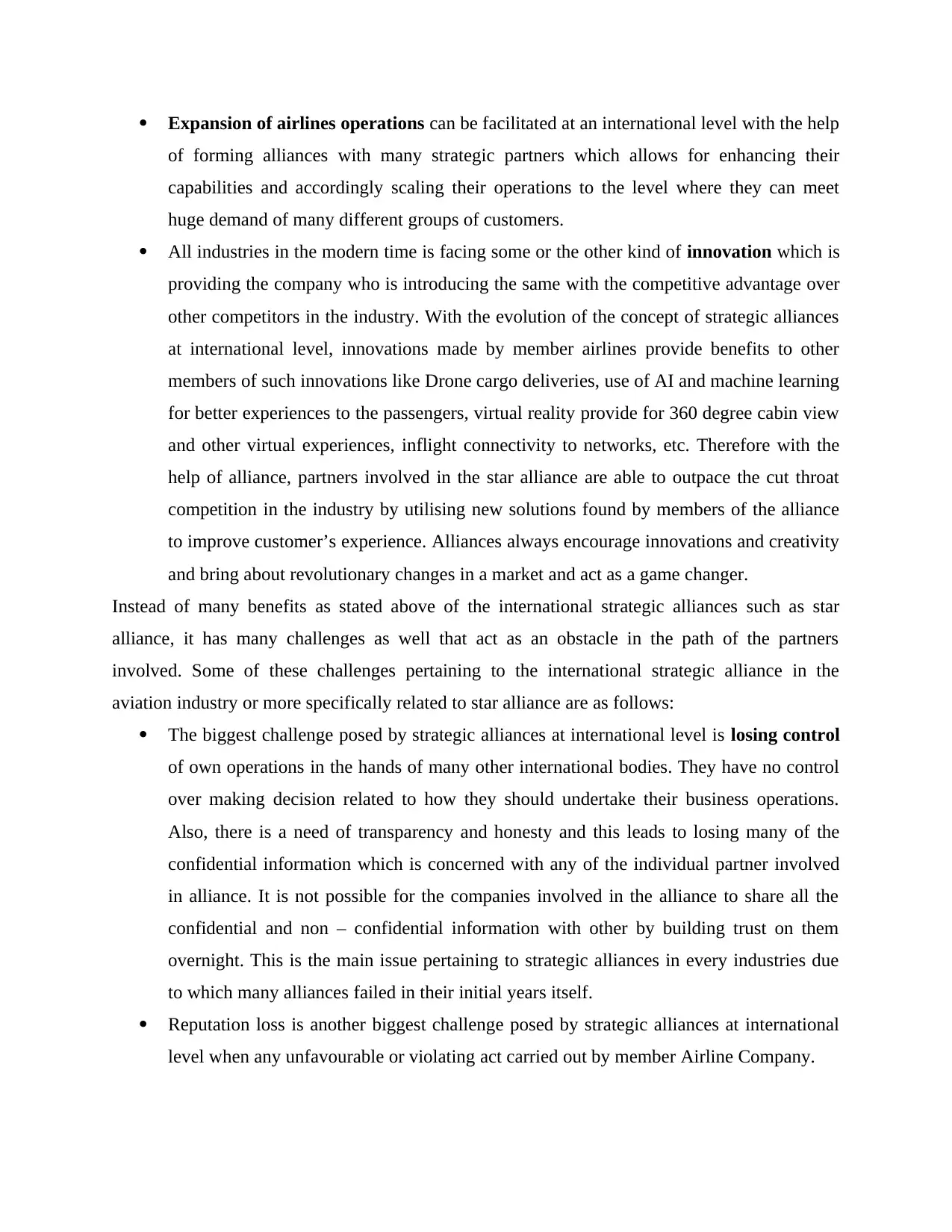
Expansion of airlines operations can be facilitated at an international level with the help
of forming alliances with many strategic partners which allows for enhancing their
capabilities and accordingly scaling their operations to the level where they can meet
huge demand of many different groups of customers.
All industries in the modern time is facing some or the other kind of innovation which is
providing the company who is introducing the same with the competitive advantage over
other competitors in the industry. With the evolution of the concept of strategic alliances
at international level, innovations made by member airlines provide benefits to other
members of such innovations like Drone cargo deliveries, use of AI and machine learning
for better experiences to the passengers, virtual reality provide for 360 degree cabin view
and other virtual experiences, inflight connectivity to networks, etc. Therefore with the
help of alliance, partners involved in the star alliance are able to outpace the cut throat
competition in the industry by utilising new solutions found by members of the alliance
to improve customer’s experience. Alliances always encourage innovations and creativity
and bring about revolutionary changes in a market and act as a game changer.
Instead of many benefits as stated above of the international strategic alliances such as star
alliance, it has many challenges as well that act as an obstacle in the path of the partners
involved. Some of these challenges pertaining to the international strategic alliance in the
aviation industry or more specifically related to star alliance are as follows:
The biggest challenge posed by strategic alliances at international level is losing control
of own operations in the hands of many other international bodies. They have no control
over making decision related to how they should undertake their business operations.
Also, there is a need of transparency and honesty and this leads to losing many of the
confidential information which is concerned with any of the individual partner involved
in alliance. It is not possible for the companies involved in the alliance to share all the
confidential and non – confidential information with other by building trust on them
overnight. This is the main issue pertaining to strategic alliances in every industries due
to which many alliances failed in their initial years itself.
Reputation loss is another biggest challenge posed by strategic alliances at international
level when any unfavourable or violating act carried out by member Airline Company.
of forming alliances with many strategic partners which allows for enhancing their
capabilities and accordingly scaling their operations to the level where they can meet
huge demand of many different groups of customers.
All industries in the modern time is facing some or the other kind of innovation which is
providing the company who is introducing the same with the competitive advantage over
other competitors in the industry. With the evolution of the concept of strategic alliances
at international level, innovations made by member airlines provide benefits to other
members of such innovations like Drone cargo deliveries, use of AI and machine learning
for better experiences to the passengers, virtual reality provide for 360 degree cabin view
and other virtual experiences, inflight connectivity to networks, etc. Therefore with the
help of alliance, partners involved in the star alliance are able to outpace the cut throat
competition in the industry by utilising new solutions found by members of the alliance
to improve customer’s experience. Alliances always encourage innovations and creativity
and bring about revolutionary changes in a market and act as a game changer.
Instead of many benefits as stated above of the international strategic alliances such as star
alliance, it has many challenges as well that act as an obstacle in the path of the partners
involved. Some of these challenges pertaining to the international strategic alliance in the
aviation industry or more specifically related to star alliance are as follows:
The biggest challenge posed by strategic alliances at international level is losing control
of own operations in the hands of many other international bodies. They have no control
over making decision related to how they should undertake their business operations.
Also, there is a need of transparency and honesty and this leads to losing many of the
confidential information which is concerned with any of the individual partner involved
in alliance. It is not possible for the companies involved in the alliance to share all the
confidential and non – confidential information with other by building trust on them
overnight. This is the main issue pertaining to strategic alliances in every industries due
to which many alliances failed in their initial years itself.
Reputation loss is another biggest challenge posed by strategic alliances at international
level when any unfavourable or violating act carried out by member Airline Company.
⊘ This is a preview!⊘
Do you want full access?
Subscribe today to unlock all pages.

Trusted by 1+ million students worldwide
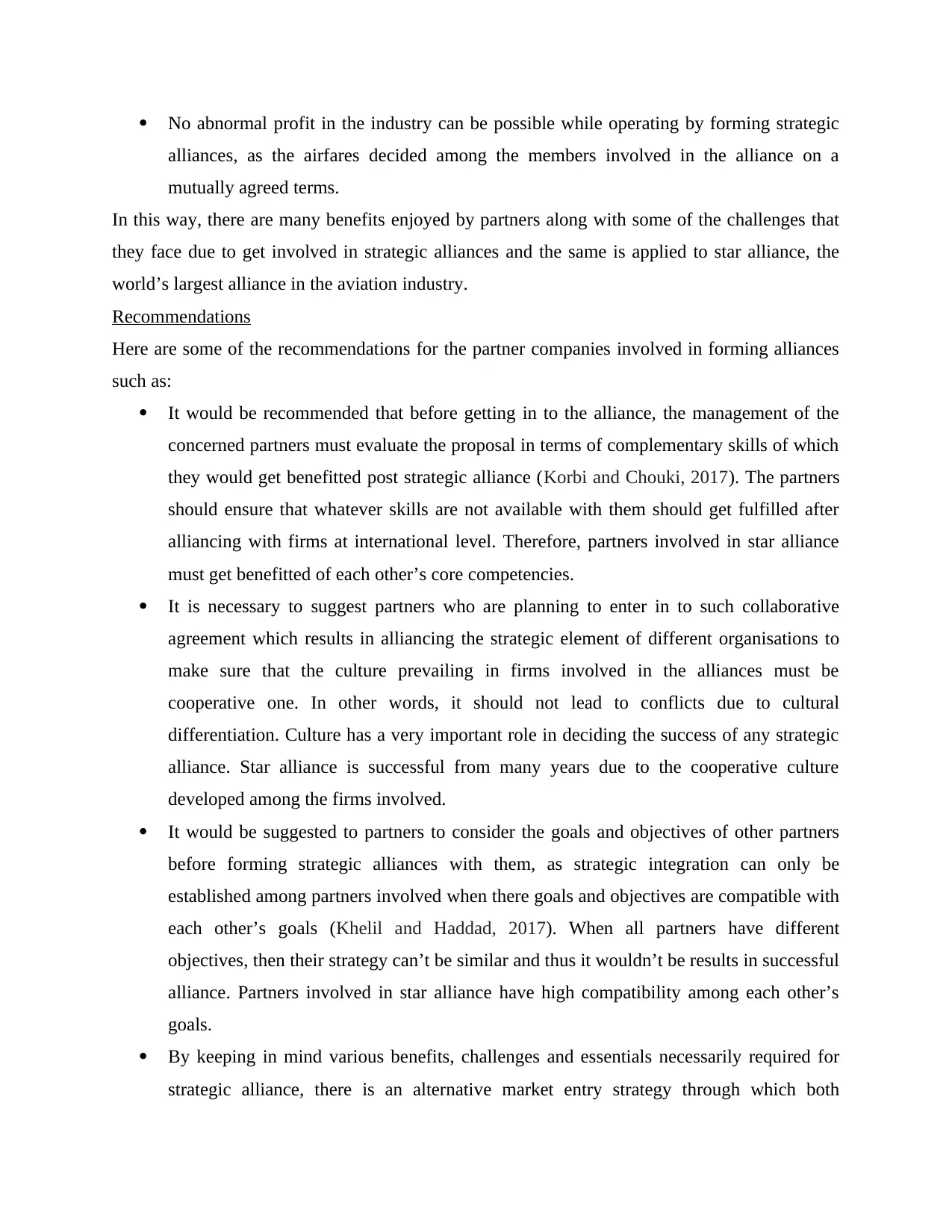
No abnormal profit in the industry can be possible while operating by forming strategic
alliances, as the airfares decided among the members involved in the alliance on a
mutually agreed terms.
In this way, there are many benefits enjoyed by partners along with some of the challenges that
they face due to get involved in strategic alliances and the same is applied to star alliance, the
world’s largest alliance in the aviation industry.
Recommendations
Here are some of the recommendations for the partner companies involved in forming alliances
such as:
It would be recommended that before getting in to the alliance, the management of the
concerned partners must evaluate the proposal in terms of complementary skills of which
they would get benefitted post strategic alliance (Korbi and Chouki, 2017). The partners
should ensure that whatever skills are not available with them should get fulfilled after
alliancing with firms at international level. Therefore, partners involved in star alliance
must get benefitted of each other’s core competencies.
It is necessary to suggest partners who are planning to enter in to such collaborative
agreement which results in alliancing the strategic element of different organisations to
make sure that the culture prevailing in firms involved in the alliances must be
cooperative one. In other words, it should not lead to conflicts due to cultural
differentiation. Culture has a very important role in deciding the success of any strategic
alliance. Star alliance is successful from many years due to the cooperative culture
developed among the firms involved.
It would be suggested to partners to consider the goals and objectives of other partners
before forming strategic alliances with them, as strategic integration can only be
established among partners involved when there goals and objectives are compatible with
each other’s goals (Khelil and Haddad, 2017). When all partners have different
objectives, then their strategy can’t be similar and thus it wouldn’t be results in successful
alliance. Partners involved in star alliance have high compatibility among each other’s
goals.
By keeping in mind various benefits, challenges and essentials necessarily required for
strategic alliance, there is an alternative market entry strategy through which both
alliances, as the airfares decided among the members involved in the alliance on a
mutually agreed terms.
In this way, there are many benefits enjoyed by partners along with some of the challenges that
they face due to get involved in strategic alliances and the same is applied to star alliance, the
world’s largest alliance in the aviation industry.
Recommendations
Here are some of the recommendations for the partner companies involved in forming alliances
such as:
It would be recommended that before getting in to the alliance, the management of the
concerned partners must evaluate the proposal in terms of complementary skills of which
they would get benefitted post strategic alliance (Korbi and Chouki, 2017). The partners
should ensure that whatever skills are not available with them should get fulfilled after
alliancing with firms at international level. Therefore, partners involved in star alliance
must get benefitted of each other’s core competencies.
It is necessary to suggest partners who are planning to enter in to such collaborative
agreement which results in alliancing the strategic element of different organisations to
make sure that the culture prevailing in firms involved in the alliances must be
cooperative one. In other words, it should not lead to conflicts due to cultural
differentiation. Culture has a very important role in deciding the success of any strategic
alliance. Star alliance is successful from many years due to the cooperative culture
developed among the firms involved.
It would be suggested to partners to consider the goals and objectives of other partners
before forming strategic alliances with them, as strategic integration can only be
established among partners involved when there goals and objectives are compatible with
each other’s goals (Khelil and Haddad, 2017). When all partners have different
objectives, then their strategy can’t be similar and thus it wouldn’t be results in successful
alliance. Partners involved in star alliance have high compatibility among each other’s
goals.
By keeping in mind various benefits, challenges and essentials necessarily required for
strategic alliance, there is an alternative market entry strategy through which both
Paraphrase This Document
Need a fresh take? Get an instant paraphrase of this document with our AI Paraphraser
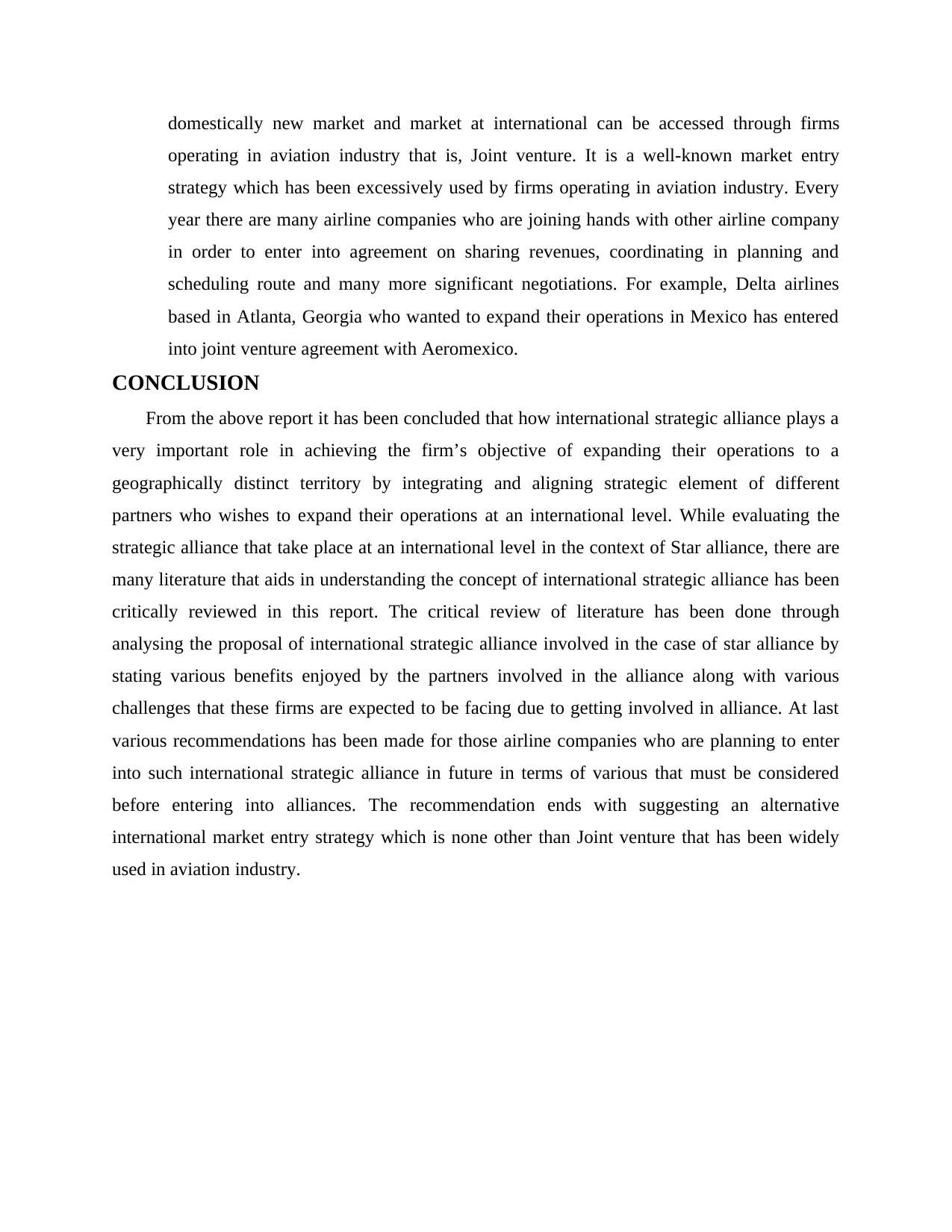
domestically new market and market at international can be accessed through firms
operating in aviation industry that is, Joint venture. It is a well-known market entry
strategy which has been excessively used by firms operating in aviation industry. Every
year there are many airline companies who are joining hands with other airline company
in order to enter into agreement on sharing revenues, coordinating in planning and
scheduling route and many more significant negotiations. For example, Delta airlines
based in Atlanta, Georgia who wanted to expand their operations in Mexico has entered
into joint venture agreement with Aeromexico.
CONCLUSION
From the above report it has been concluded that how international strategic alliance plays a
very important role in achieving the firm’s objective of expanding their operations to a
geographically distinct territory by integrating and aligning strategic element of different
partners who wishes to expand their operations at an international level. While evaluating the
strategic alliance that take place at an international level in the context of Star alliance, there are
many literature that aids in understanding the concept of international strategic alliance has been
critically reviewed in this report. The critical review of literature has been done through
analysing the proposal of international strategic alliance involved in the case of star alliance by
stating various benefits enjoyed by the partners involved in the alliance along with various
challenges that these firms are expected to be facing due to getting involved in alliance. At last
various recommendations has been made for those airline companies who are planning to enter
into such international strategic alliance in future in terms of various that must be considered
before entering into alliances. The recommendation ends with suggesting an alternative
international market entry strategy which is none other than Joint venture that has been widely
used in aviation industry.
operating in aviation industry that is, Joint venture. It is a well-known market entry
strategy which has been excessively used by firms operating in aviation industry. Every
year there are many airline companies who are joining hands with other airline company
in order to enter into agreement on sharing revenues, coordinating in planning and
scheduling route and many more significant negotiations. For example, Delta airlines
based in Atlanta, Georgia who wanted to expand their operations in Mexico has entered
into joint venture agreement with Aeromexico.
CONCLUSION
From the above report it has been concluded that how international strategic alliance plays a
very important role in achieving the firm’s objective of expanding their operations to a
geographically distinct territory by integrating and aligning strategic element of different
partners who wishes to expand their operations at an international level. While evaluating the
strategic alliance that take place at an international level in the context of Star alliance, there are
many literature that aids in understanding the concept of international strategic alliance has been
critically reviewed in this report. The critical review of literature has been done through
analysing the proposal of international strategic alliance involved in the case of star alliance by
stating various benefits enjoyed by the partners involved in the alliance along with various
challenges that these firms are expected to be facing due to getting involved in alliance. At last
various recommendations has been made for those airline companies who are planning to enter
into such international strategic alliance in future in terms of various that must be considered
before entering into alliances. The recommendation ends with suggesting an alternative
international market entry strategy which is none other than Joint venture that has been widely
used in aviation industry.
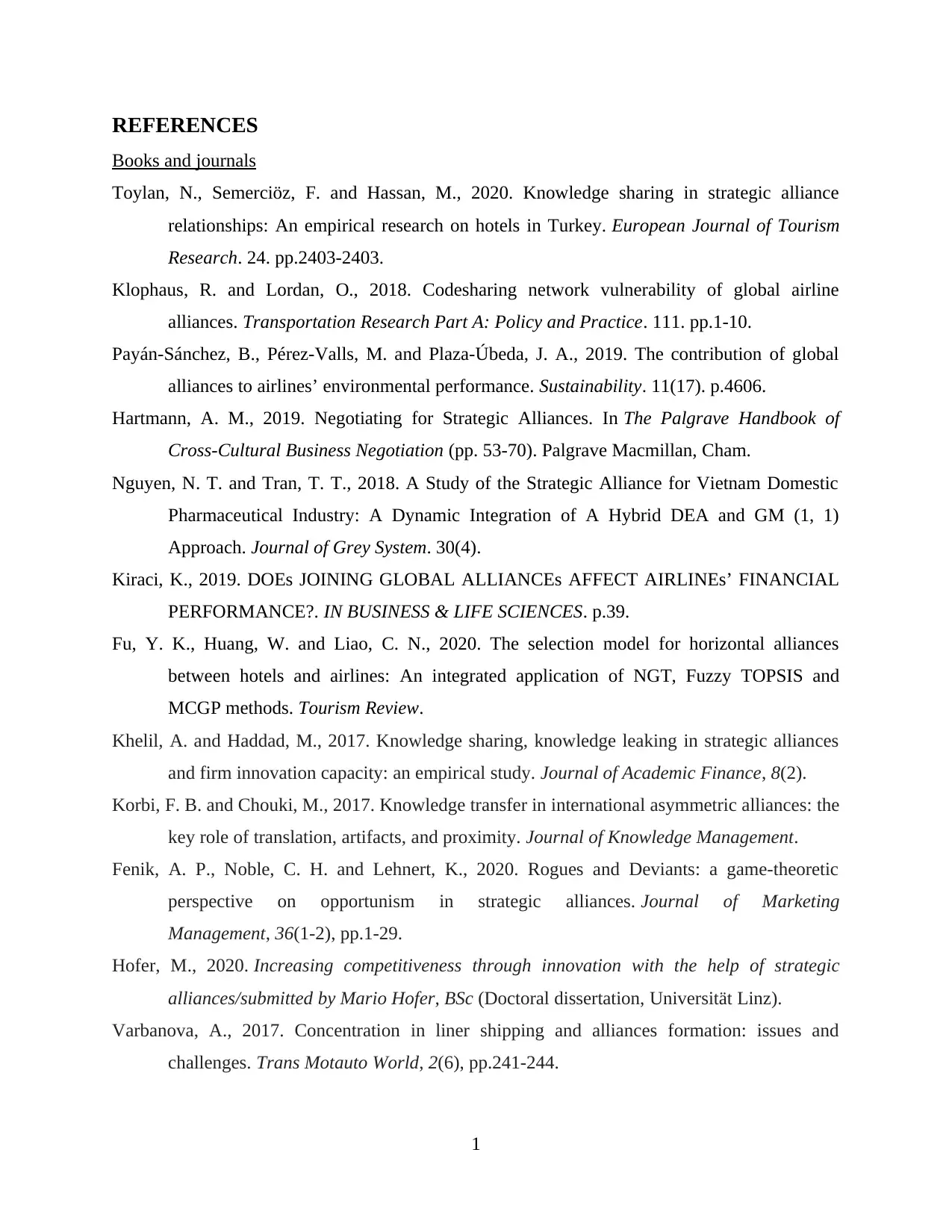
REFERENCES
Books and journals
Toylan, N., Semerciöz, F. and Hassan, M., 2020. Knowledge sharing in strategic alliance
relationships: An empirical research on hotels in Turkey. European Journal of Tourism
Research. 24. pp.2403-2403.
Klophaus, R. and Lordan, O., 2018. Codesharing network vulnerability of global airline
alliances. Transportation Research Part A: Policy and Practice. 111. pp.1-10.
Payán-Sánchez, B., Pérez-Valls, M. and Plaza-Úbeda, J. A., 2019. The contribution of global
alliances to airlines’ environmental performance. Sustainability. 11(17). p.4606.
Hartmann, A. M., 2019. Negotiating for Strategic Alliances. In The Palgrave Handbook of
Cross-Cultural Business Negotiation (pp. 53-70). Palgrave Macmillan, Cham.
Nguyen, N. T. and Tran, T. T., 2018. A Study of the Strategic Alliance for Vietnam Domestic
Pharmaceutical Industry: A Dynamic Integration of A Hybrid DEA and GM (1, 1)
Approach. Journal of Grey System. 30(4).
Kiraci, K., 2019. DOEs JOINING GLOBAL ALLIANCEs AFFECT AIRLINEs’ FINANCIAL
PERFORMANCE?. IN BUSINESS & LIFE SCIENCES. p.39.
Fu, Y. K., Huang, W. and Liao, C. N., 2020. The selection model for horizontal alliances
between hotels and airlines: An integrated application of NGT, Fuzzy TOPSIS and
MCGP methods. Tourism Review.
Khelil, A. and Haddad, M., 2017. Knowledge sharing, knowledge leaking in strategic alliances
and firm innovation capacity: an empirical study. Journal of Academic Finance, 8(2).
Korbi, F. B. and Chouki, M., 2017. Knowledge transfer in international asymmetric alliances: the
key role of translation, artifacts, and proximity. Journal of Knowledge Management.
Fenik, A. P., Noble, C. H. and Lehnert, K., 2020. Rogues and Deviants: a game-theoretic
perspective on opportunism in strategic alliances. Journal of Marketing
Management, 36(1-2), pp.1-29.
Hofer, M., 2020. Increasing competitiveness through innovation with the help of strategic
alliances/submitted by Mario Hofer, BSc (Doctoral dissertation, Universität Linz).
Varbanova, A., 2017. Concentration in liner shipping and alliances formation: issues and
challenges. Trans Motauto World, 2(6), pp.241-244.
1
Books and journals
Toylan, N., Semerciöz, F. and Hassan, M., 2020. Knowledge sharing in strategic alliance
relationships: An empirical research on hotels in Turkey. European Journal of Tourism
Research. 24. pp.2403-2403.
Klophaus, R. and Lordan, O., 2018. Codesharing network vulnerability of global airline
alliances. Transportation Research Part A: Policy and Practice. 111. pp.1-10.
Payán-Sánchez, B., Pérez-Valls, M. and Plaza-Úbeda, J. A., 2019. The contribution of global
alliances to airlines’ environmental performance. Sustainability. 11(17). p.4606.
Hartmann, A. M., 2019. Negotiating for Strategic Alliances. In The Palgrave Handbook of
Cross-Cultural Business Negotiation (pp. 53-70). Palgrave Macmillan, Cham.
Nguyen, N. T. and Tran, T. T., 2018. A Study of the Strategic Alliance for Vietnam Domestic
Pharmaceutical Industry: A Dynamic Integration of A Hybrid DEA and GM (1, 1)
Approach. Journal of Grey System. 30(4).
Kiraci, K., 2019. DOEs JOINING GLOBAL ALLIANCEs AFFECT AIRLINEs’ FINANCIAL
PERFORMANCE?. IN BUSINESS & LIFE SCIENCES. p.39.
Fu, Y. K., Huang, W. and Liao, C. N., 2020. The selection model for horizontal alliances
between hotels and airlines: An integrated application of NGT, Fuzzy TOPSIS and
MCGP methods. Tourism Review.
Khelil, A. and Haddad, M., 2017. Knowledge sharing, knowledge leaking in strategic alliances
and firm innovation capacity: an empirical study. Journal of Academic Finance, 8(2).
Korbi, F. B. and Chouki, M., 2017. Knowledge transfer in international asymmetric alliances: the
key role of translation, artifacts, and proximity. Journal of Knowledge Management.
Fenik, A. P., Noble, C. H. and Lehnert, K., 2020. Rogues and Deviants: a game-theoretic
perspective on opportunism in strategic alliances. Journal of Marketing
Management, 36(1-2), pp.1-29.
Hofer, M., 2020. Increasing competitiveness through innovation with the help of strategic
alliances/submitted by Mario Hofer, BSc (Doctoral dissertation, Universität Linz).
Varbanova, A., 2017. Concentration in liner shipping and alliances formation: issues and
challenges. Trans Motauto World, 2(6), pp.241-244.
1
⊘ This is a preview!⊘
Do you want full access?
Subscribe today to unlock all pages.

Trusted by 1+ million students worldwide
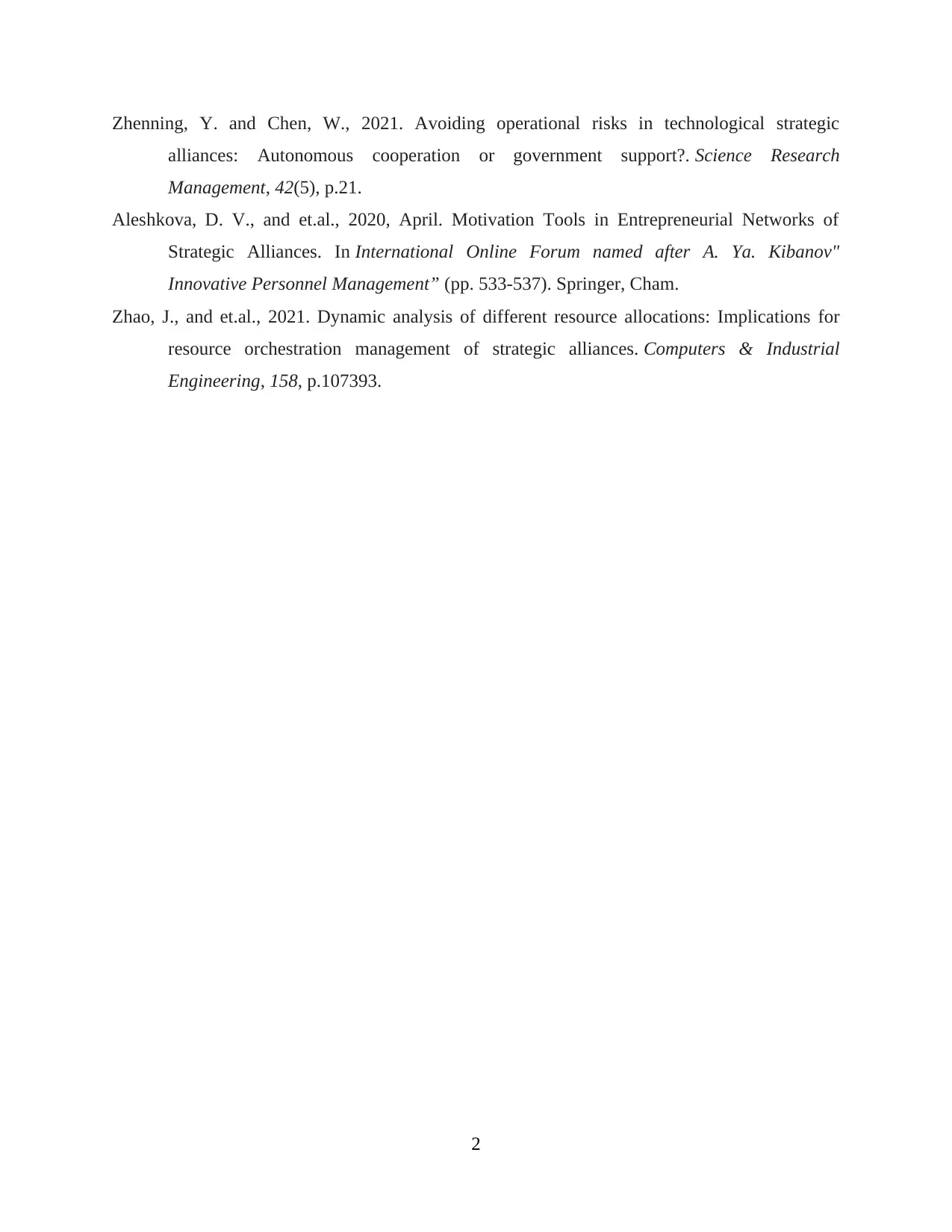
Zhenning, Y. and Chen, W., 2021. Avoiding operational risks in technological strategic
alliances: Autonomous cooperation or government support?. Science Research
Management, 42(5), p.21.
Aleshkova, D. V., and et.al., 2020, April. Motivation Tools in Entrepreneurial Networks of
Strategic Alliances. In International Online Forum named after A. Ya. Kibanov"
Innovative Personnel Management” (pp. 533-537). Springer, Cham.
Zhao, J., and et.al., 2021. Dynamic analysis of different resource allocations: Implications for
resource orchestration management of strategic alliances. Computers & Industrial
Engineering, 158, p.107393.
2
alliances: Autonomous cooperation or government support?. Science Research
Management, 42(5), p.21.
Aleshkova, D. V., and et.al., 2020, April. Motivation Tools in Entrepreneurial Networks of
Strategic Alliances. In International Online Forum named after A. Ya. Kibanov"
Innovative Personnel Management” (pp. 533-537). Springer, Cham.
Zhao, J., and et.al., 2021. Dynamic analysis of different resource allocations: Implications for
resource orchestration management of strategic alliances. Computers & Industrial
Engineering, 158, p.107393.
2
Paraphrase This Document
Need a fresh take? Get an instant paraphrase of this document with our AI Paraphraser

3
1 out of 14
Related Documents
Your All-in-One AI-Powered Toolkit for Academic Success.
+13062052269
info@desklib.com
Available 24*7 on WhatsApp / Email
![[object Object]](/_next/static/media/star-bottom.7253800d.svg)
Unlock your academic potential
© 2024 | Zucol Services PVT LTD | All rights reserved.





